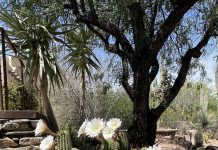The jungle of Belize served as an IUPUC biology student’s classroom this summer. There he hoped to discover a wider array of mayfly species than what is currently known.
David Cool, a North Vernon resident, spent the end of June in the mountainous Central American country to study mayflies, a group of insects that live in fresh water. He joined researchers from Sonoma State University and the University of California-Davis, which were there studying a variety of insects.
Cool got his interest in mayflies from IUPUC assistant professor Luke Jacobus, who has studied the insects for 18 years.
Mayflies are important for a variety of factors, including being a food source for fish, birds and other animals, and as bio-indicators, Jacobus and Cool said.
[sc:text-divider text-divider-title=”Story continues below gallery” ]
“Mayflies are very sensitive to many changes in their immediate environment and they are used to monitor environmental health,” Jacobus said.
Guatemala, a neighboring country to Belize, has 68 known mayfly species while Belize only has 26, Cool said. This is mostly due to a lack of research done in the area, he added.
Cool hoped to find two specific species — C. montanus and C. pictus — as both have been found in Guatemala and species of the genus have been found in Belize, Cool said. However, because Cool arrived during the rainy season, he did not find the amount of adult mayflies he wanted.
“Unfortunately, I found most of what I was looking for had already emerged and mated, leaving only a few straggling adults in the air and very small larvae in the streams,” Cool said.
Cool got the chance to go to Belize after Jacobus declined to go due to prior engagements and recommended Cool for the job, Cool said. He secured a grant to help with some of the expenses and he paid for the rest out of pocket.
To prepare, Jacobus taught Cool how to collect mayflies and to observe their behavior and habitats, but the biggest challenge he faced was outside of his study — the natural dangers of the jungle.
“There were confirmed sightings of at least one jaguar on the property, there were multiple deadly snakes, including the fer-de-lance or ‘ultimate pit viper,’ and weaving trails of army and leaf cutter ants all over the property,” Cool said.
Cool was the only mayfly specialist there, which meant he did his work alone — often at night — in and along creeks.
“A sobering feeling to say the least,” Cool said of the experience.
Despite the danger and lack of mayfly specimens for him to study, Cool took pictures of other insects, such as moths that would flock to the camp at night. The researchers hung up white sheets surrounded by lights to draw insects out of the forests, he said.
The mayfly specimens he did collect had to be taken to California with the group leaders, but he expects to receive them soon.
Cool plans to collaborate on a paper with another mayfly specialist on mayflies of both Mexico and Belize.
[sc:pullout-title pullout-title=”David Cool” ][sc:pullout-text-begin]
Age: 26
Resides: North Vernon
High school: Jennings County High School
College: Biology student specializing in mayflies at IUPUC in Columbus
Parents: Stan and Karen Cool
Siblings: Andrea Cool-Wittwer, Brian Cool and Amanda Gorsuch
Interests/hobbies: Kayaking, hiking and riding his motorcycle to see new places
[sc:pullout-text-end]




